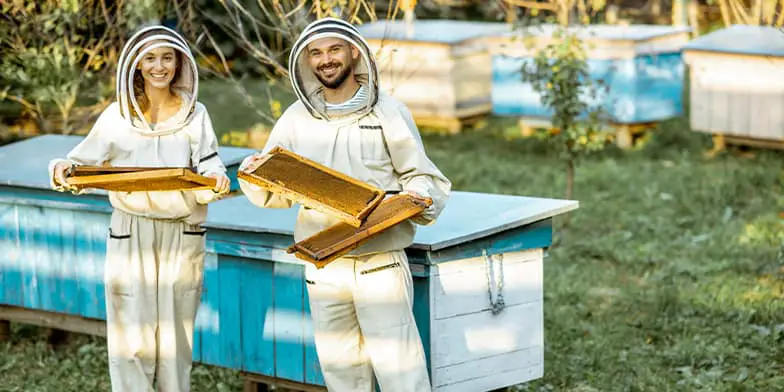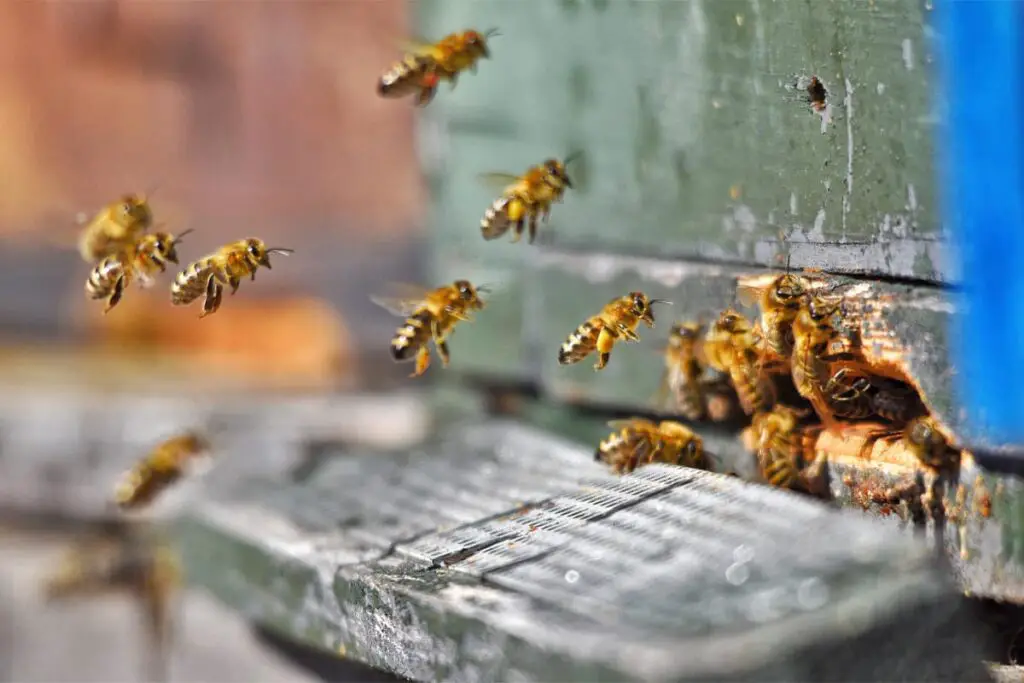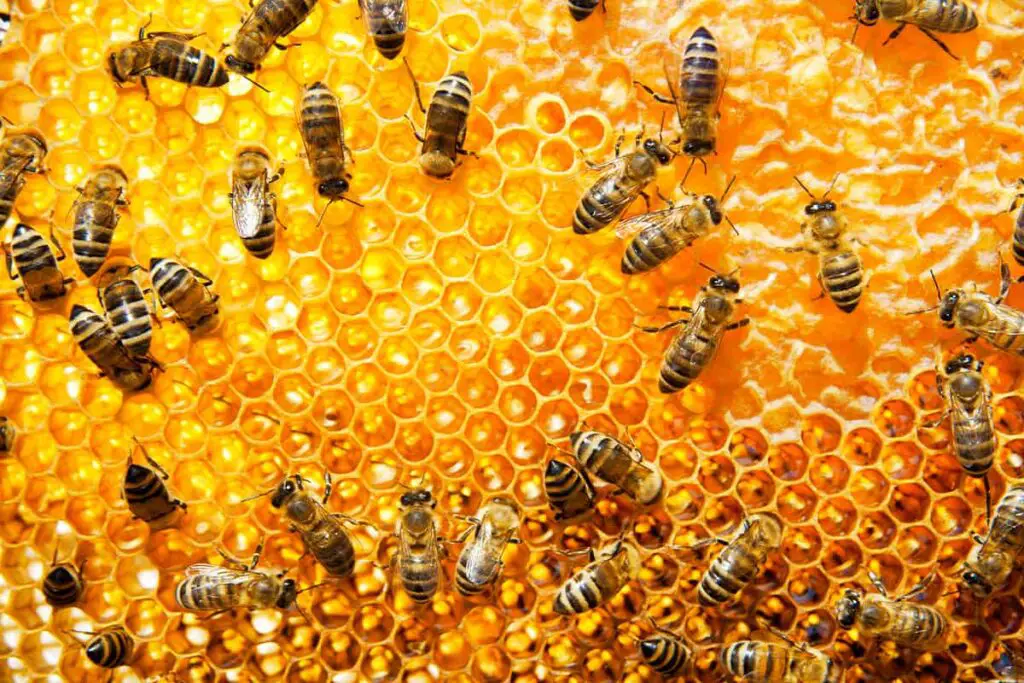
Bees (like most other insects) are harmless when left alone. Sometimes, however, an encounter is unavoidable, and whether you’re a professional or not – no one likes getting stung.
Have you ever noticed that sometimes bees will be more aggressive towards some people than others? The answer to this mystery might be as easy as the color of the clothing they are wearing.
Most bees and wasps hate colors that are on the darker side of the palette. Shades like black and dark grey make bees feel threatened, and they will respond in kind. In addition to dark hues, red, maroon or violet might also enrage bees. If you’re planning on being near a beehive, it would be a wise decision to avoid wearing these colors.
In this article we’re going to explore why bees interpret these colors in the way they do, and how you can avoid being painfully stung over your fashion choices.
Do Bees Hate Color?
Bees do not hate all colors, but certain pigments pose a degree of threat to them. Bees or wasps will predominantly prefer shades like blue or yellow. This is biological, as tints of yellow will attract them to certain plants and flowers.
Here are a few reasons why bees will prefer some colors, and react negatively to others.
A Lack of Trichromatic Eyesight
In human eyes, three base colors are combined to make up all of the other shades in a similar way to how a computer program will render color to your screen. These three colors are red, blue and green. Unlike us, bees do not have trichromatic eyes and instead have what is called monochromatic vision. Bees will base their perception on a combination of hues including ultraviolet light, blue and green.
Monochromatic vision aids the bee, as these shades form the lighter tones that they can perceive even from a distance. They can also detect the tinge of colors even when travelling at high speed. This is why certain pigments will attract them from a long way away.

Light Shades Attract Bees
Bees help plants reproduce by seeking out their nectar, but thousands (and even millions) of years ago, plants and flowers were very different from what they are today. There were not as many variations in the shade of nectar as there are now. Over the centuries, bees have become attuned to collecting pollen from brighter colors, and will prefer them over darker tones. Some of the light shades of color bees are most attracted to include:
- Yellow
- Blue
- Purple
- Violet
The brighter and more colorful the flowers are, the more they will attract bees. Yellow is one of the prime colors which attract these little insects, so most bees will make a beeline to yellow flowers.
Bees have nothing but positive connotations with these shades. When humans wear similarly colored clothing, the bees will come over to check them out, but they won’t attack. They’re simply curious!
What Colors Do Bees Hate?
Just as bees have a clear set of choices that they like to adhere to when it comes to pollen collection, they also have a set of colors that they’ve adapted to react aggressively towards. Among the darker shades of grey and black, bees also hate tones like:
- Red
- Violet
- Purple
- Dark Pink
- Crimson
- Maroon
Bees are generally peaceful insects, but they will still respond to perceived threats, especially to their home. As such, professionals working with bees will usually wear light dye clothes to send the signal that they’re not a threat. Light shades such as tan or neutral shades, brown or beige, or maybe even complete white, will make bees feel like you are no longer a threat to them.

To a bee, the color red (and similar colors such as indigo and pink) are interpreted as the most dangerous of all the non-black shades. This is because the vision of a bee can’t see red, and they mistake it for black.
For the sake of personal safety, it is always better to avoid wearing red and other reddish hues. Wearing red, maroon, pink or any similar intense color may just send the wrong signal. If you do not want to be mistaken for food, the safest colors to wear are neutral tones such as tan, beige or brown. This way, you can keep out of the bees way, they can keep out of yours.
Why Do Bees Hate Some Colors?
Some studies have shown that although the color precision of a bees eyesight is much better than that of the average human, their monochromatic vision prevents them from seeing specific shades.
Red, in particular, will present as black to a bee. Very dark colors are threatening to these little insects, so anything that is colored red will be interpreted as something to be defended against.
Photoreceptive Sense
Bees hate some colors more than others when they cannot see them well. When flying through the wide field of flowers, bees will run into a range of shades that all have a different appeal to them. Time after time, they will prioritize, and be drawn to, flowers with blue or yellow petals and nectar. Why does this happen?
This behaviour occurs because bees can perceive wavelengths from approximately 300 to 650 nanometers. For comparison, humans on average can see between 380 and 700. This means bees can see the ultraviolet spectrum, which is invisible to the naked human eye, but they cannot see red because they do not have the photoreceptor of red in their eyes.
To a bee, the world just looks different. Some hues are more pronounced, and others appear black.
Researches learned all of this by running a series of experiments where bees were exposed to different wavelengths. They observed the bees responding to some, and completely ignoring others.
Unique Eye Structure
A bee has five eyes. The two larger eyes at the front are compound eyes, and these are the ones sensitive to the ultraviolet spectrum. These eyes have a single lens each, so entomologists refer to them as ‘simple’ eyes.
They help bees sense light instead of shapes or forms of the objects. Honey bees see with the help of ocelli, which also helps them maneuver into vast flower fields.
The other base colors of bees’ eyes include purple and green. These pigments individually signal different shades to bees’ eye cells. Their ocelli help them spot the lighter shades first, which is another reason why they might avoid dark colors.
Conclusion
Hopefully now you’re more aware of how our friend, the bee, sees our world. If you’re planning to go on a trip to visit a beehive and were wondering what colors bees hate, I hope I’ve helped you pick the appropriate wardrobe to wear.
Most professional farmers or honey collectors would recommend wearing neutral, pale or uniform colors to stay away from the bee attack zone. Avoid reds and blacks at all costs, and if you do not want to appear as food to them, then do not wear yellow or blue either.
Driven by a passion for those tiny creatures that rule our world, we at Bug Domain strive to be your go-to resource for information on insects.




